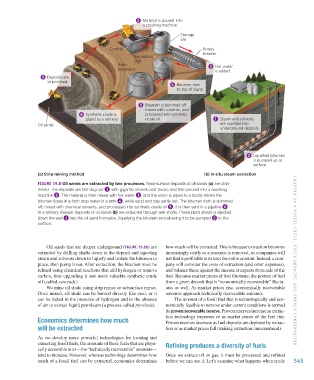Page 546 - Environment: The Science Behind the Stories
P. 546
2 Material is poured into
a crushing machine.
Storage
silo
Crusher Rotary
breaker
Separation
Unit
Froth 3 Hot water
treatment is added.
1 Deposits are
strip-mined.
4 Bitumen rises
to top of slurry.
5 Bitumen is skimmed off,
mixed with solvents, and
6 Synthetic crude is processed into synthetic
piped to a refinery. crude oil. 1 Steam and solvents
Oil sands are injected into
underground deposits
2 Liquefied bitumen
is pumped up to
surface
(a) Strip-mining method (b) In-situ steam extraction
FIGURE 19.8 Oil sands are extracted by two processes. Near-surface deposits of oil sands (a) are strip-
mined. The deposits are first dug out 1 with gigantic shovels and trucks and then poured into a crushing
machine 2 . The material is then mixed with hot water 3 , and the slurry is piped to a facility where the
bitumen floats in a froth atop water in a tank 4 , while sand and clay settle out. The bitumen froth is skimmed
off, mixed with chemical solvents, and processed into synthetic crude oil 5 ; it is then sent in a pipeline 6
to a refinery. Deeper deposits of oil sands (b) are extracted through well shafts. Pressurized steam is injected
down the well 1 into the oil sand formation, liquefying the bitumen and allowing it to be pumped 2 to the
surface.
Oil sands that are deeper underground (FIGURE 19.8b) are how much will be extracted. This is because extraction becomes
extracted by drilling shafts down to the deposit and injecting increasingly costly as a resource is removed, so companies will
steam and solvents down to liquefy and isolate the bitumen in not find it profitable to extract the entire amount. Instead, a com- CHAPTER 19 • FOSSIL FUELS, THEIR IMPA CT S, AND ENERGY CONSERVATI ON
place, then pump it out. After extraction, the bitumen must be pany will consider the costs of extraction (and other expenses),
refined using chemical reactions that add hydrogen or remove and balance these against the income it expects from sale of the
carbon, thus upgrading it into more valuable synthetic crude fuel. Because market prices of fuel fluctuate, the portion of fuel
oil (called syncrude). from a given deposit that is “economically recoverable” fluctu-
We mine oil shale using strip mines or subsurface mines. ates as well. As market prices rise, economically recoverable
Once mined, oil shale can be burned directly like coal, or it amounts approach technically recoverable amounts.
can be baked in the presence of hydrogen and in the absence The amount of a fossil fuel that is technologically and eco-
of air to extract liquid petroleum (a process called pyrolysis). nomically feasible to remove under current conditions is termed
its proven recoverable reserve. Proven reserves increase as extrac-
Economics determines how much tion technology improves or as market prices of the fuel rise.
Proven reserves decrease as fuel deposits are depleted by extrac-
will be extracted tion or as market prices fall (making extraction uneconomical).
As we develop more powerful technologies for locating and
extracting fossil fuels, the amounts of these fuels that are physi- Refining produces a diversity of fuels
cally accessible to us—the “technically recoverable” amounts—
tend to increase. However, whereas technology determines how Once we extract oil or gas, it must be processed and refined
much of a fossil fuel can be extracted, economics determines before we can use it. Let’s examine what happens when crude 545
M19_WITH7428_05_SE_C19.indd 545 12/12/14 5:22 PM

